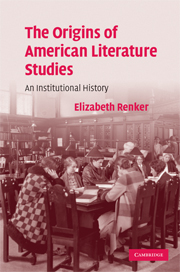Book contents
- Frontmatter
- Contents
- Acknowledgments
- Introduction
- Chapter 1 The birth of the Ph.D.: The Johns Hopkins research model
- Chapter 2 Seminary wars: female teachers and the seminary model at Mount Holyoke
- Chapter 3 Higher education for African Americans: competing models at Wilberforce University
- Chapter 4 Literary value and the land-grant model: The Ohio State University
- Conclusion: the end of the curriculum
- Notes
- Bibliography
- Archives consulted
- Index
Chapter 3 - Higher education for African Americans: competing models at Wilberforce University
Published online by Cambridge University Press: 22 September 2009
- Frontmatter
- Contents
- Acknowledgments
- Introduction
- Chapter 1 The birth of the Ph.D.: The Johns Hopkins research model
- Chapter 2 Seminary wars: female teachers and the seminary model at Mount Holyoke
- Chapter 3 Higher education for African Americans: competing models at Wilberforce University
- Chapter 4 Literary value and the land-grant model: The Ohio State University
- Conclusion: the end of the curriculum
- Notes
- Bibliography
- Archives consulted
- Index
Summary
Located in the small town of Xenia in western Ohio, Wilberforce University was founded in 1856 with an aim almost inconceivable at the time: to provide higher education for “Negroes.” A decade later, the cataclysmic social changes of the post-emancipation period would generate a surge in the number of Negro colleges, universities, and normal schools, hundreds of which were founded between 1865 and 1900. These schools attempted to succeed in an ideological climate that primarily supported two kinds of Negro education: training in manual labor and training as teachers, specifically as teachers for other Negroes. In the parlance of the time, “industrial,” “manual,” “trade,” “vocational,” “agricultural,” “mechanical,” and “normal” education were kinds of training considered suitable for black students, part of a larger effort to train them for subordinate positions in American society. This chapter will show how the installation of American literature at Wilberforce University enacted the social programs meant to limit curricula, jobs, and status for black people.
The programmatic location for American literature at Wilberforce was the normal program, and its social function as a subject was of a piece with the normal curriculum that housed it: to train teachers for lower-level Negro schools. It was not the content of the American literature classes but their institutional location that acted as the lens through which they acquired meaning.
- Type
- Chapter
- Information
- The Origins of American Literature StudiesAn Institutional History, pp. 64 - 94Publisher: Cambridge University PressPrint publication year: 2007



